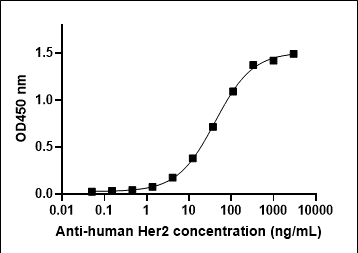ERBB2 Human Recombinant Protein
CAT#: TP721314
Human Her2 Protein (C-His)
View other "Her2" proteins (18)
|
Need it in bulk or customized? Get a free quote |
CNY 2,450.00
CNY 1,999.00
CNY 2,700.00
Specifications
| Product Data | |
| Species | Human |
| Expression Host | CHO |
| Expression cDNA Clone or AA Sequence |
Ser22-Thr652
|
| Tag | C-His |
| Predicted MW | The protein has a predicted molecular weight of 71 kDa and migrates at approximately 80 kDa on SDS-PAGE with DTT-reduced conditions. |
| Concentration | 25µg size is bottled at 0.2mg/mL concentration. 100 µg size is bottled at lot specific concentration. |
| Purity | >90% |
| Buffer | 1xPBS buffer, pH7.4 |
| Preparation | Affinity Ni-NTA |
| Applications | ELISA |
| Storage | An unopened vial can be stored at 4°C for 2 weeks or at -20°C and below for six months. This stock solution should be aliquoted and stored at ≤ -70°C to minimize the freeze/thaw cycles. |
| Stability | 6 Months |
| Bioactivity | PositiveThe definition of the active protein (purified and biotinylated) is defined as the protein that can bind to its biological receptor/ligand. For conjugated protein, it is defined with its function to bind to the ScFv of the active CAR-transfected cells in flow cytometry test. |
| Reference Data | |
| RefSeq | NP_004439.2 |
| Locus ID | 2064 |
| UniProt ID | P04626 |
| Summary | Human epithelial growth factor receptor 2 (HER2), also named ErbB2/Neu receptor, is a member of the epidermal growth factor receptor (EGFR; also known as ErbB) family of receptor tyrosine kinases. In human, this family are consisted of four members: HER1 (EGFR, ERBB1), HER2 (ERBB2), HER3 (ERBB3) and HER4 (ERBB4). The HER family proteins are type I transmembrane growth factor receptors that function to activate intracellular signaling pathways in response to extracellular signals. Their structure consists of an extracellular ligand binding domain, a transmembrane domain, and an intracellular tyrosine kinase domain. Unlike other members of the family, HER2 lacks ligand binding activity and its signaling function is engaged by its ligand-bound heterodimeric partners. Its expression has a close relationship with various tumors. Its overexpression is found in malignant tumors, such as breast, ovarian, gastric, and colorectal cancers. |
| Protein Families | ELISA |
| Protein Pathways | Adherens junction, Bladder cancer, Calcium signaling pathway, Endometrial cancer, ErbB signaling pathway, Focal adhesion, Non-small cell lung cancer, Pancreatic cancer, Pathways in cancer, Prostate cancer |
Documents
| FAQs |
| SDS |
Resources
| 蛋白相关资源 |
Other Versions
| SKU | Description | Size | Price |
|---|---|---|---|
| LC417979 | ERBB2 HEK293T cell transient overexpression lysate (as WB positive control) |
CNY 1,470.00 |
|
| LC423666 | ERBB2 HEK293T cell transient overexpression lysate (as WB positive control) |
CNY 1,470.00 |
|
| LY417979 | Transient overexpression lysate of v-erb-b2 erythroblastic leukemia viral oncogene homolog 2, neuro/glioblastoma derived oncogene homolog (avian) (ERBB2), transcript variant 1 |
CNY 4,840.00 |
|
| LY423666 | Transient overexpression lysate of v-erb-b2 erythroblastic leukemia viral oncogene homolog 2, neuro/glioblastoma derived oncogene homolog (avian) (ERBB2), transcript variant 2 |
CNY 4,840.00 |
|
| PH312583 | ERBB2 MS Standard C13 and N15-labeled recombinant protein (NP_004439) |
CNY 19,520.00 |
|
| PH322909 | ERBB2 MS Standard C13 and N15-labeled recombinant protein (NP_001005862) |
CNY 19,520.00 |
|
| TP312583 | Recombinant protein of human v-erb-b2 erythroblastic leukemia viral oncogene homolog 2, neuro/glioblastoma derived oncogene homolog (avian) (ERBB2), transcript variant 1, 20 µg |
CNY 2,900.00 |
|
| TP322909 | Recombinant protein of human v-erb-b2 erythroblastic leukemia viral oncogene homolog 2, neuro/glioblastoma derived oncogene homolog (avian) (ERBB2), transcript variant 2, 20 µg |
CNY 2,900.00 |
|
| TP700105 | Recombinant protein of human v-erb-b2 erythroblastic leukemia viral oncogene homolog 2, neuro/glioblastoma derived oncogene homolog (avian) (ERBB2), transcript variant 1, extracellular domain, 20 µg |
CNY 6,650.00 |
|
| TP710004 | Recombinant protein of human v-erb-b2 erythroblastic leukemia viral oncogene homolog 2,neuro/glioblastoma derived oncogene homolog (avian) (ERBB2),residues 676-1255aa,with C-terminal DDK tag,expressed in sf9s, 20ug |
CNY 4,020.00 |
|
| TP710032 | Recombinant protein of human v-erb-b2 erythroblastic leukemia viral oncogene homolog 2, neuro/glioblastoma derived oncogene homolog (avian) (ERBB2), full length, with C-terminal DDK tag, expressed in sf9 cells. |
CNY 4,020.00 |
|
| TP710036 | Recombinant protein of human v-erb-b2 erythroblastic leukemia viral oncogene homolog 2, neuro/glioblastoma derived oncogene homolog (avian) (ERBB2), residues 23-652aa, with C-terminal DDK tag, expressed in sf9 cells. |
CNY 4,020.00 |
|
| TP721313 | Human Her2 Protein (C-Fc) |
CNY 2,450.00 |
|
| TP721315 | Human HER2 Protein (C-His-Avi) |
CNY 2,450.00 |
|
| TP721316 | Biotinylated Human HER2 Protein (C-His-Avi) |
CNY 3,480.00 |
|
| TP721317 | PE Conjugated Human Her2 Protein (C-His) |
CNY 3,480.00 |
|
| TP721318 | APC Conjugated Human Her2 Protein (C-His) |
CNY 3,480.00 |
|
| TP790102 | Purified recombinant protein of Human v-erb-b2 erythroblastic leukemia viral oncogene homolog 2, neuro/glioblastoma derived oncogene homolog (avian) (ERBB2), transcript variant 1, full length, with C-terminal DDK tag,expressed in CHO cells; |
CNY 6,650.00 |


 United States
United States
 Germany
Germany
 Japan
Japan
 United Kingdom
United Kingdom
 China
China


